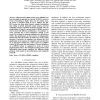Free Online Productivity Tools
i2Speak
i2Symbol
i2OCR
iTex2Img
iWeb2Print
iWeb2Shot
i2Type
iPdf2Split
iPdf2Merge
i2Bopomofo
i2Arabic
i2Style
i2Image
i2PDF
iLatex2Rtf
Sci2ools
JCP
2008
2008
Practical Chip-level Equalizers in HSDPA
High-speed downlink packet access (HSDPA) has been developed to upgrade the current WCDMA system in yerms of providing a higher data rate for mobile users. To ensure a downlink speed of up to 14Mbps, the HSDPA system has three main features: adaptive modulation and coding, a hybrid automatic repeat request, and fast scheduling. Because standard documents describe only the specifications of Node B, various kinds of HSDPA receivers cen be used with different architectures. An ordinary receiver generally has a rake architecture, though a rake receiver is not good at reducing multiple access interference (MAI). The performance of rake receiver is indispensably deteriorated when the number of mobile users in the system increases. Conversely, an equalizer can alleviate the MAI significantly at the expense of complexity and can therefore be an alternative solution for a rake receiver in a HSDPA system. In this paper, the performance of several equalizers of a HSDPA system is compared in terms...
HSDPA | JCP 2008 | Mobile Users | Rake Receiver |
| Added | 13 Dec 2010 |
| Updated | 13 Dec 2010 |
| Type | Journal |
| Year | 2008 |
| Where | JCP |
| Authors | Minjae Park, Woonsik Lee, Minh-Viet Nguyen, Hwang Soo Lee |
Comments (0)

